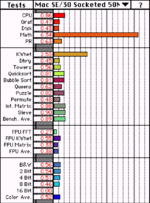I'm testing out a DayStar Universal PowerCache card in my IIci. It's the 50MHz 68030 version, so it *should* be wicked fast. And it's certainly faster than the IIci in stock form, but the benchmarks suggest it's not performing as it should.
The IIci has 20MB of RAM and is running System 7.0.1 with 32-bit addressing enabled. I have the PowerCache control panel installed, and both the cache and FPU are enabled, and it says the 50MHz 030 is active. The thing is, MacBench 2 says that the system (with card) only performs at 60% of what a IIfx does (that one has a 40MHz 030), though FPU scores are comparable. Speedometer rates the CPU at .74, while an entry for "50MHz SE/30" (there's no saved score for a IIfx) has a CPU rating of .87. (A stock IIci is rated at .40.) Some individual tests (whetstones, etc) are faster with the PowerCache, but not all.
For a card that was advertised as making a IIci faster than a IIfx, what gives? Is this a bus limitation in the IIci that the IIfx doesn't have, or does this card not benchmark well?

